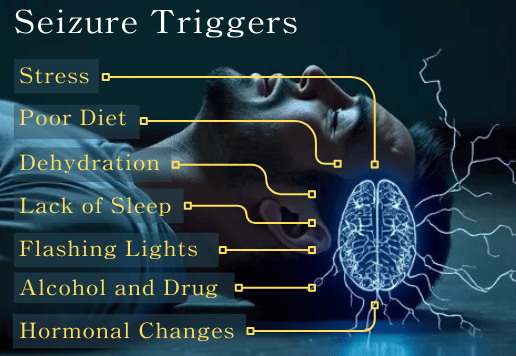
Navigating Life with Epilepsy: Understanding, Managing, and Supporting (Part-2)
SPECIALIZED CARE TECHNIQUES
Part 2: The Art of Recognizing Seizure Triggers and Keeping a Seizure Diary
Part Two of our epilepsy awareness series focuses on recognizing and managing seizure triggers, a vital aspect of epilepsy care. This guide provides insights into common triggers such as lack of sleep, stress, alcohol and drug use, photosensitivity, poor diet, and hormonal changes. By understanding these factors, caregivers can better predict and prevent seizures, creating a safer and more supportive environment for their loved ones. Practical advice, including maintaining a seizure diary, is offered to help caregivers and individuals with epilepsy navigate daily life with confidence and empathy.


Putting together Day Two's installment focusing on 'Recognizing Triggers,' a critical aspect for epilepsy management, I see we have the outline ready to go. Let's delve into understanding what might set off a seizure and how awareness can help manage these episodes effectively. As always, our focus remains on helping you support your loved one with empathy and knowledge.
Recognizing Triggers:
Understanding what might trigger a seizure is crucial for anyone caring for an individual with epilepsy. Let's break down some of these common triggers and how we can mitigate their impact:
Lack of Sleep: Just like our other bodily functions, our brains need rest to function correctly. A consistent sleep schedule and a comforting bedtime routine can be instrumental in keeping seizures at bay. Darkness, quiet, and relaxation before bed are your friends.
Stress: It's no secret that stress is an inherent part of life. However, for someone with epilepsy, it could tip the scales toward a seizure. Stress management techniques like meditation, deep breathing exercises, or engaging in hobbies and activities can help maintain peace within your loved one.
Alcohol and Drug Use: Alcoholic beverages should be consumed responsibly as they can affect the central nervous system and interact with anti-epileptic drugs. Similarly, drug use—both recreational and prescription—can also pose risks to someone with epilepsy and must be monitored closely by a healthcare provider.
Flashing Lights (Photosensitivity): For about 3% of individuals with epilepsy, certain visual stimuli can trigger seizures. If you know your loved one is sensitive to light, being proactive in minimizing exposure—like reducing screen time or avoiding environments that feature flickering lights—can protect them from such events.
Skipping Meals or Poor Diet: Our bodies rely on a steady source of energy provided by the food we consume. Fluctuations in blood sugar levels can be enough to provoke seizures, so it's vital to maintain balanced and consistent meals throughout the day. Some individuals might find specific diets beneficial; consulting with a dietitian could offer further insights tailored specifically for your loved one.
Hormonal Changes: Many women notice that their seizures tend to fluctuate around certain times in their menstrual cycle or during pregnancy and menopause. If this is something you observe, it's imperative to have a clear line of communication with the healthcare provider who can offer solutions or adjustments to manage these changes.
In addition to these common triggers, there are others like fever, certain medications, dehydration, and extreme temperatures that can also impact seizure susceptibility. It's important to be observant and note any patterns that might emerge in your loved one's life as they could provide valuable clues for managing their condition better.
Keeping a Seizure Diary:
A seizure diary is an indispensable tool when it comes to identifying triggers, understanding patterns, and communicating effectively with healthcare providers. This simple yet powerful record can track crucial details like the types of seizures experienced, time and date, potential triggers, emotional or physical activity beforehand, sleep patterns, medication schedules, and more. With this information, both you and your loved one's doctor can work together to create a tailored management plan.
Here's a summary of key elements typically included in a seizure diary:
Personal Information:
Name, address, contact details
Emergency contact information
Medical team details (GP, neurologist, epilepsy nurse)
Seizure Types:
Description of different seizure types experienced
Codes or names for each seizure type (e.g., A, B, C)
Daily Log:
Date and time of seizure
Seizure type/code
Whether awake or asleep when seizure occurred
Duration of seizure
Number of seizures (if multiple)
Additional Details:
Any warning signs or auras
Potential triggers
Recovery time
Emergency medication used
Hospital treatment required
How you felt before and after the seizure
Medication Tracking:
Daily record of whether medication was taken
Changes in medication or dosage
Side effects experienced
Monthly Summary:
Calendar view to mark seizures at a glance
Total number of seizures per month
Appointments:
Dates and details of medical appointments
Notes Section:
Space for additional comments or questions for the doctor
In summary:
As we continue to uncover more about this complex condition, remember that each step towards understanding and management makes a world of difference. Stay tuned as we explore the upcoming topics in our series, including lifestyle adjustments for epilepsy management, creating a seizure response plan, and much more. Together with knowledge and heartfelt support, you can weather any storm brought on by this condition known as epilepsy.
With the second installment of our blog post series complete, we've taken a closer look at common triggers that can provoke seizures and how to manage them effectively. Recognizing these triggers is not only empowering for individuals with epilepsy but also crucial for caregivers who can help create environments safest from potential episodes. Keep an eye out for our next post, where we will guide you on lifestyle adjustments that could further aid in managing this condition day-to-day.
Related Article
More for you



